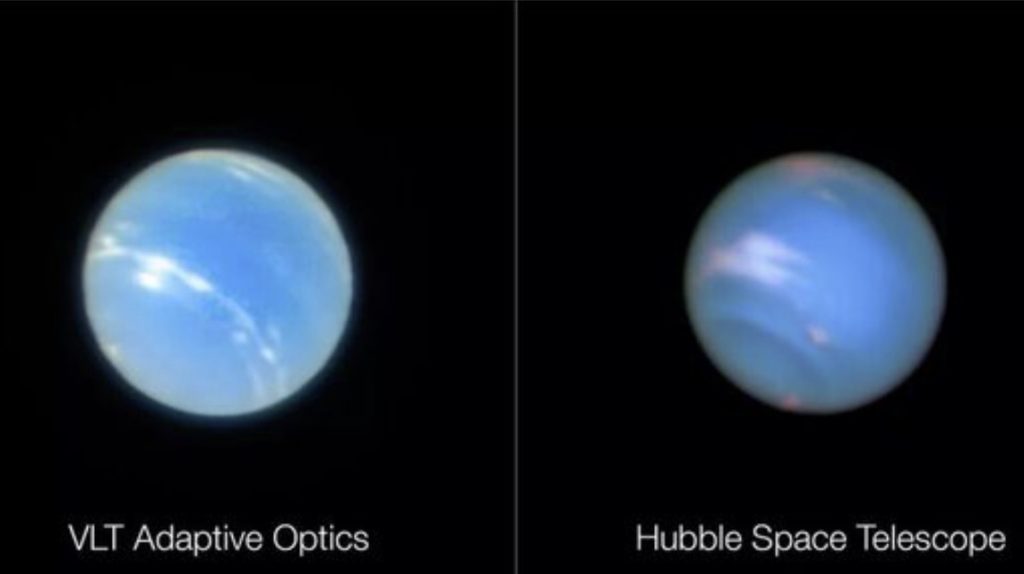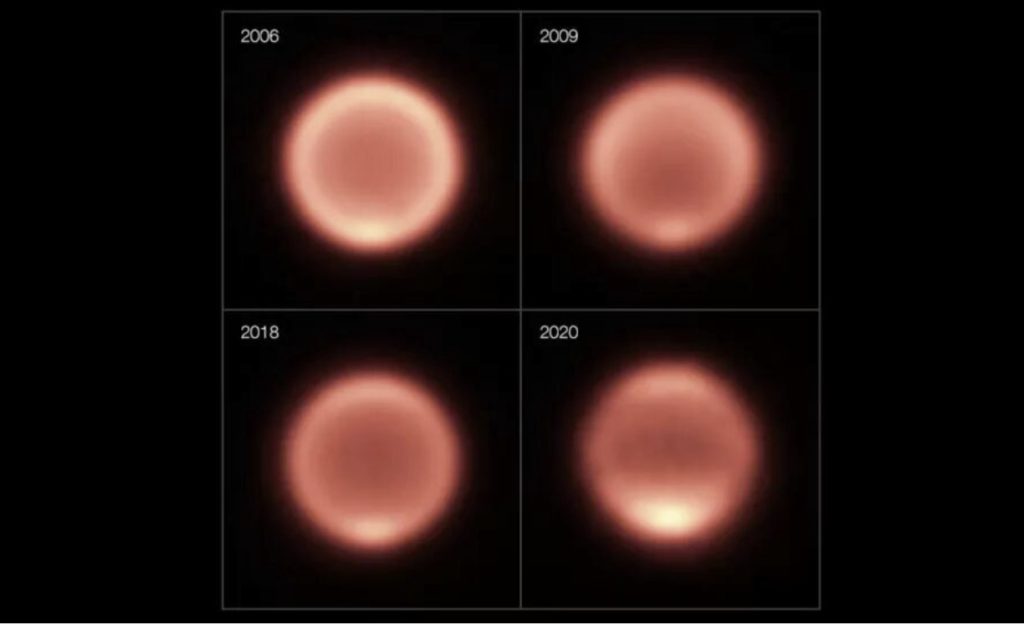
Two decades worth of observations revealed unexpected cooling of the solar system’s most distant planet Neptune amid its astronomical summer.
Neptune is orbiting 30 times farther away from the sun than Earth with one year lasting 165 Earth years. The ice giant’s seasons, too, last much longer than those on Earth — more than 40 Earth-years each.
Preparedness: Protect your home and car with the best lightning and EMP protection available…
As the planet moved into its southern summer over the past two decades, astronomers observed its average global temperatures plummet by a staggering 14 degrees Fahrenheit (8 degrees Celsius).
“This change was unexpected,” Michael Roman, a postdoctoral research associate at the University of Leicester and lead author on the new paper, said in a statement. “Since we have been observing Neptune during its early southern summer, we would expect temperatures to be slowly growing warmer, not colder.”
Here is a GIF showing how Neptune’s thermal-infrared appearance has changed over time since 2003. You can see that the disk of Neptune varies in 12-micron brightness, which we interpret as temperature changes in the stratosphere. Brighter is warmer and darker is colder. pic.twitter.com/oNYnQbAotq
— Michael Roman (@Michael_T_Roman) April 11, 2022
The team analyzed observations in the heat-carrying infrared part of the light spectrum obtained from 2003 to 2018 by some of the world’s best telescopes including the European Southern Observatory’s (ESO) Very Large Telescope in Chile, the Keck and Subaru Telescopes in Hawai’i, and NASA’s Spitzer Space Telescope.
Preparedness: Get this filter to drink clean water at home!
The observed cooling, however, wasn’t uniform, the researchers said in the statement.
Measurements of Neptune’s stratosphere, the second lowest layer of the planet’s atmosphere, revealed a warming trend above Neptune’s south pole. This data set, which only contained data from a two-year period between 2018 and 2020, revealed a speedy warming of about 20 degrees F (11 degrees C). The scientists said that such polar warming has never been observed on Neptune before.
However, observations of the distant Neptune have only been possible for the past few decades and scientists know very little about the natural passing of the seasons on the planet.

“Our data cover less than half of a Neptune season,” Glenn Orton, Senior Research Scientist at JPL and co-author on the study said in the statement. “So no one was expecting to see large and rapid changes.”
Get a satellite phone to communicate with your loved ones when internet and phones are down…
Scientists don’t know yet what drives the unexpected temperature fluctuations, but think it could have something to do with the 11-year cycle of the sun’s activity, the periodic ebb and flow of sunspot generation by the star.
“The temperature variations may be related to seasonal changes in Neptune’s atmospheric chemistry, which can alter how effectively the atmosphere cools,” Roman said. “But random variability in weather patterns or even a response to the 11-year solar activity cycle may also have an effect.”
Previous studies suggested there might be a link between the amount of sunspots and Neptune’s brightness. The new study also found some evidence of a possible connection between the solar cycle, the brightness of clouds in Neptune’s atmosphere and the temperature of its stratosphere.
Scientists hope that future observations will shed more light on the distant planet’s mysteries. The James Webb Space Telescope, the most powerful space observatory ever built, is expected to make major leaps in the understanding of Neptune, as well as of the other solar system ice giant, Uranus.
Preparedness: Buy GOLD and SILVER at best prices…
“The exquisite sensitivity of [JWST’s] mid-infrared instrument, MIRI, will provide unprecedented new maps of the chemistry and temperatures in Neptune’s atmosphere, helping to better identify the nature of these recent changes,” Leigh Fletcher, Professor of Planetary Science at the University of Leicester, a co-author of the new study, said in the statement.
The study was published on Monday (April 11) in the Planetary Science Journal. [Space, PSJ]
It’s notable that whilst overall Neptune is cooling there has been a noticeable warming trend at the poles. A similar change has has been documented on earth… Weird, no?
StrangeSounds.org has been banned from AD NETWORKS! You can support me here…
Things to add to your disaster & preparedness kit:
- Protect your home and car with the best lightning and EMP protection available…
- Buy GOLD and SILVER at the best prices ever…
- Need a portable power station? Better look at Jackery!
- Get a satellite phone to communicate with your loved ones when internet and phones are down…
- According to a new report, about 50% of world’s water is ‘too polluted’ for swimming, fishing or drinking. Use this filter to drink clean water at home!
- Buy the best value freeze dried emergency food around…
- Qfiles is another great site for alternative news and information…













All of this solar systems planets cool during a Maunder Minimum.
Additionally it is believed that a large planetary object ( previously/ presently not seen ) with a very elongated and elliptical orbit is transiting our solar system ( this accounts for the orbits and orientation of planetoids like Pluto ) and is currently inbound. This object has a very large gravitational pull which may result in the visible planets being pulled further from the sun resulting in the cooling of the plants themselves ( obviously ).
As evidence I give you the fact than every ancient culture prior to approximately 1000bc stated in their written histories a 360 day year, a year of 12 thirty day months. Something happened that increased the length of the year and the only thing that could account for that is that the earth literally moved further away from the sun.
Check the temps of Earth out to Pluto. You will see these planets cooling down at an even pace.
Why?
Sol, the Sun, is taking a ‘nap’.
It’s output is lessened and all of the Planets are cooling down.
Back in the late 70’s and 80’s, all of the Planets were getting warmer.
That’s when the Sun was at its max output.
This cooling/heating is cyclical and we are in a new Solar Minima (NASA).
Get ready…they say it may (Will) be 6-10% cooler than the Maunder minimum.
Add the Volcanos popping their tops off adding dust up high blocking the Sun’s energy we are and will get much COLDER.
OH…the Pole Shift that may happen soon will cause massive Equakes, tsunamis, more volcanoes popping followed by death & destruction unseen by Mankind…get ready for one Hell of a ride!
Matthew 24 explains this too.
Yeah, it’s the beginning of the end.